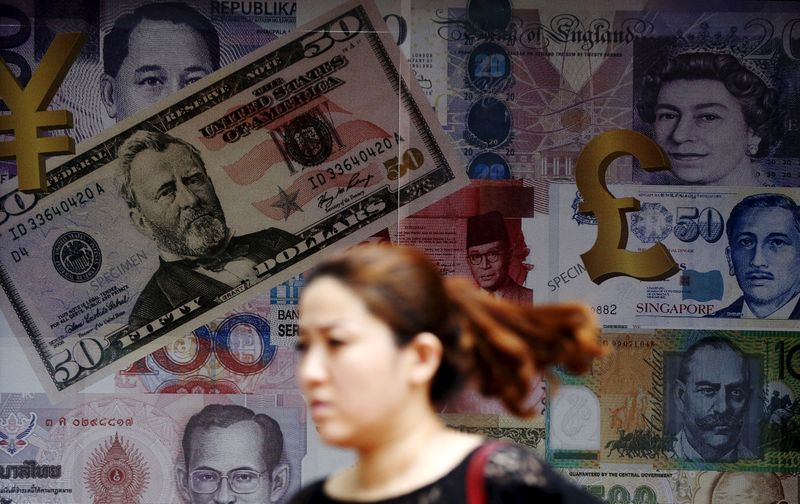By Mike Dolan
LONDON (Reuters) - To say investors were unprepared for 5% U.S. Treasury yields is perhaps the market understatement of the year - but they are now frantically feeling around to see if rates can go higher still and what landmines that might set off.
Real and nominal U.S. government borrowing rates have exploded over the past month, with benchmark 10-year yields coming within 12 basis points of the 5% mark this week for the first time since 2007.
Twenty-year bonds are now above that and 30-year paper briefly topped it on Tuesday. And in the backdrop, 30-year fixed mortgage rates have ballooned above 7.5% for the first time since 2000.
The speed of the move is breathtaking. With very little change in thinking on Federal Reserve policy rates through next year, 10-year Treasury yields have rocketed some 80bp in little over four weeks.
Investors seem to have rapidly switched their attention from cyclical ebb and flow and short-term second guessing of the Fed to the possible return of the U.S. economy to a pre-2008 high-pressure, higher interest rate environment over the longer term.
But they are also now accounting for rising debt and debt servicing costs and a likely divided and often dysfunctional congressional system of budget setting. And many fear Washington will now struggle to rein in deficits for years to come just as the Fed's balance sheet unwind removes the central bank as a stabilising force in the debt market.
Re-enter risk premia on what should be 'risk free' bonds.
This comes in the shape of the so-called 'term premium' - a sometimes nebulous measure of the compensation required to buy and hold a long-term bond as opposed to simply rolling over short-term paper at prevailing rates.
While the Fed has almost deliberately sown uncertainty about future interest rates, the term premium is really supposed to capture fear of things that can go bump in the night longer term. And that's often fiscal policy and debt supply in the absence of a central bank backstop of quantitative easing (QE).
The New York Fed's favoured measure of the term premium - actually negative for much of the past decade due largely to repeated bouts of Fed bond buying - has surged by a whopping 130bp since July to stand positive for the first time in two years and at its highest since 2015 at 35bp.
And if you think that's the end, then a quick consideration of where it used to be in a pre-2008 world puts its 65-year average at 150bp - almost another 120bp higher than today.
Even getting back to the average of the past 20 years would see it rise further to 50bp - not to mention 2013 highs of 190bp or periods during the Great Financial Crisis (GFC) about 300bp.
THERE BE DRAGONS
When you add that sort of risk premium to standing bond math on future real policy rates and inflation, the argument for long-term investors jumping back in at these elevated rates weakens considerably.
Barclays strategist Ajay Rajadhyaksha compares today's resurfaced term premium to the 50bp that existed just before the GFC - but points out that U.S. public debt to GDP levels have more than doubled since then.
"We are now facing persistently high deficits for years (and) under such circumstances, even 120-130bp in term premia might plausibly not be enough," he wrote, adding Fed models see an average 1.5% real policy rate over 10 years as plausible given 2% inflation over the period.
"Add it all up – 3.5% for the nominal policy rate and another 130bp in term premia – and the 10 year at 4.8% does not exactly scream cheap."
And if 'risk free' government bond yields have not yet peaked, then the pressure on equities, credit and mortgage markets priced off this benchmark rate only rise further too.
Another way to look at fair value in Treasuries, however, is simply to look at the nominal economic growth - published real GDP growth plus prevailing inflation - for guidance.
Societe Generale (OTC:SCGLY)'s multi-asset team seem convinced Treasuries now offer close to fair value near 5%.
Their models use a rolling annualised nominal growth average over 10 years as the best guide to 10-year yields and say this is currently throwing up 5% - putting bonds on reasonably neutral footing going forward.
The SocGen strategists point out Treasury yields were below this nominal growth measure for the past 20 years due a mix of structural disinflation from China's emergence into the world economy and serial bouts of Fed QE. Now they're just becoming better priced.
They expect a 'long plateau' for rates given that many cyclical growth signals are turning up again - and fear only a mild recession next year. The renewed corporate profits upswing riffs off this relatively robust nominal growth picture too - as do still benign corporate debt premia.
"When will rising yields become a problem leading to a potential default risk? The answer is when the profit/growth cycle turns negative," they conclude, adding the catalyst for peak bond yields will likely be an external demand shock from China or Europe.
However, keeping a lid on 5% nominal GDP may well be what's irking bonds as much as anything. While turning 10-year averages takes some time, nominal GDP growth according to a real time model from the Atlanta Fed is closer to 8% right now.

And perhaps that is really what's keeping wider credit markets relatively calm even as bedrock bonds quake.
The opinions expressed here are those of the author, a columnist for Reuters.